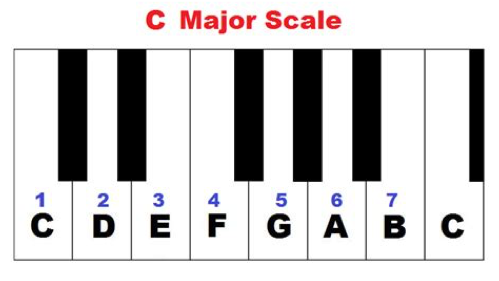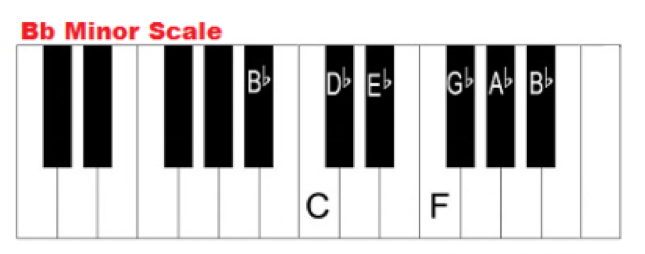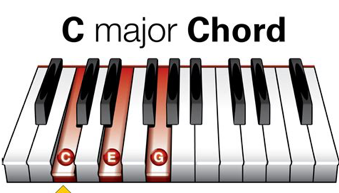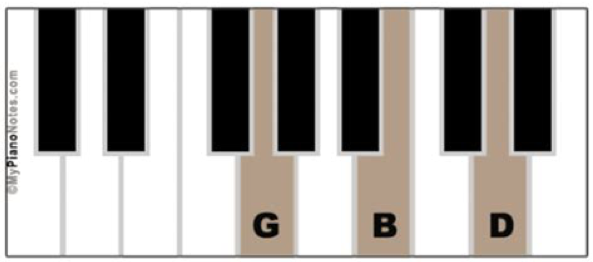By: Gavin Swift
Hi there! In this article we’re going to be learning the basics about the chords of the piano; we’re even going to go ahead and learn a few!
Even if you’ve no grand ambitions of becoming a concert pianist, knowing the basic structures of the chords of the piano serves as an incredible foundation to build an awesome musical career. Thankfully, there’s really not much to it, and once you’ve got some basics down you can start playing some fantastic (and really well known!) songs straight off the bat!
So don your best tuxedo and let’s meet at the grand piano (or upright, or electric keyboard, or MIDI-controller, or smartphone/tablet app).
Want to learn way faster and avoid any pitfalls like injuries? Try a free in-person online lesson from one of our world class instructors today.
In this lesson we’re going to learn:
What exactly is a chord? (Piano or otherwise)
Some of the basic piano chords commonly used, and how to learn & play them
How to play A LOT of seriously well-known and well-loved songs!
“But wait? Why should I learn chords for the piano?”
Oh I hear you –
‘Why oh why should I open up another cupboard in my brain to store more information about music theory when I just want to create my own music!’
And the pianists among you are probably thinking:
‘I just want to play like Benjamin Grosvenor! Why should I waste time on chords when I want to start practicing the Rachmaninov Piano Concerto No.3!’
Valid questions. But don’t worry; I’ve got a super-ultra-perfectly-valid response to both:
Numero Uno: Learning these basic piano chords upfront will save you HEAPS of time in trying to make your own music. They set in place a structure and frame work within the merry boundaries of which you can play and deliver ultimate expression with joyous simplicity. You’re music is the Ferrari, and, compadre, I’m about to give you the keys.
Numero Dos: Spoiler alert: Benjamin Grosvenor (slash, insert ANY pianist who’s career you’re longing to emulate (and that sentence can most likely be expanded to ANY MUSICIAN whose career you’d like to emulate) most certainly learnt these chords, and probably VERY early on in their journey. Navigating Rach 3 (or any piece of music on the piano) is a whole lot simpler when you’ve got an understanding of chords to guide you. As well as being the keys to your musical Ferrari, chords are also the internal SATNAV. That’s because while the chord progressions and structures of classical music are often more complex than say, pop music, classical music consists primarily of chord progressions all the same.
To give you but a glimpse of the power of four basic chords (which we’ll be learning in this session), have a look at this YouTube mash up:
Oh that Ferrari’s purring and ready to let loose! Let’s fly!
What is a chord?
‘Yeah – what is that?’
OK. So we know what a note is right? It’s the equivalent of a key on the piano, or a string on the guitar or violin. Pressing different keys on the piano or different positions on a stringed instrument produce different notes.
The fancy word for a note is a pitch.
If we look at a labelled diagram of a piano:
We can see that every 12th key is the same note. On a full piano keyboard, which has 88 keys (so 88 notes), we have up to 8 repetitions of the same note, but they don’t sound the same
or rather not exactly the same. With each repetition going up the keyboard, the essence of the note (or pitch) remains, but also sounds higher. Vice versa going down the keyboard sounding lower.
We call these groups of notes pitch classes, and there are 12 in total.
There’s some incredibly cool science & maths behind why pitches & pitch classes occur like this, all to do with the length of the string being plucked or pipe being blown – but that’s another article (or a 3am Google search for you, young padewan).
“This sounds an awful lot like theory…”
I know! But don’t worry! We’re about to apply this knowledge so stick with me! It will be so worth it when you’re playing Carnegie Hall! And midway through your finger-smoke solo a tiny thought will enter your mind:
(whispered)
“I’m so glad I read that article and learnt about pitches and pitch classes before learning more about chords”
(Shout out to me and my mum on that day please guvnor.)
Back to it:
Pitches and pitch classes are the DNA of chords and music.
Or the nuts and bolts of that Ferrari I referenced earlier – choose your metaphor! It’s your life!
They are the building blocks…
…and from there we can build a mighty fortress. Oh no! Another metaphor!
(angrier voice) “SO WHAT IS A CHORD?!”
Ah yes, that question we asked 3 paragraphs ago. Don’t worry, it was all worthwhile because now I can enlighten you.
A Chord
Is a combination of any two pitches or more.
And that’s it amigo.
C & E? You betcha. E & B? most certainly! B & B♭? You wouldn’t play it on your grandmother’s birthday (unless you’re a sadist) but it is indeed A CHORD.
The terminology ‘chord’ derives from the same etymology as ‘accord’ – as in the notes are working in accord, or working in harmony together. You probably already know this (you’re so good like that) but harmony is the name we give to the study of chords!
Fun fact – the snake we call ‘an adder’ was originally called ‘a nadder’. Sometimes language is almost as great as music. Back to it.
The most commonly used chords are…
The Triads
“Like organised gangs of Chinese criminals?”
If that’s what you’re after then you’re at the wrong article my friend. We only approve of crime here if it features in an opera or musical. And sometimes in a lyrical tune, but even that’s pushing it…
A triad is a combination of three pitches (tri- meaning three, & ad- meaning…umm, please Google this and write in, they didn’t teach me that at university).
There are two main types of triad (there are more, but that’s another article), MAJOR triads, and MINOR triads. They are both awesome and used in a 3:1 ratio in all those pop songs mashed up at the above YouTube link.
Nooooow we’re getting somewhere
Yes indeed we are. I hope you’ve got your seat belt on because now we’ve done a safety briefing and located all the exits it is time to Take. Off.
So. A Major Triad looks like this:
And is generally described as sounding ‘happy’ :)
A minor triad looks like this:
And is generally described as sounding ‘sad’ :(
The anatomy of a Major triad
Take a look at the diagram of the C Major triad overhead. The first pitch in the sequence is a C. If we count the keys going up to the next note (C=0, C#=1, etc.) we’ll find that E is 4 notes or pitches away from C. We call this interval between two notes a major third. If we continue to count up, we’ll find that the next note, G, is 3 notes or pitches away from E. We call this interval a minor third.
So a major triad is actually a combination of a major third with a minor third stacked on top.
Now let’s take a look at minor triads…
The anatomy of a Minor triad
Now looking at the above diagram of a C Minor triad, let’s apply the same analysis.
Counting up from C (where C=0), the next note in the chord is E♭, is 3 notes/pitches away.
Uh oh!
Yes mon amie, it is our old friend, the minor third interval, but in the construction of this type of chord, he is the foundation.
Counting up from E♭, the next note in the chord is G, and it is 4 notes/pitches away.
Double uh oh!
Yes indeed my friend – brutal truths are being revealed left, right and center in this article! The second part of a minor chord is constructed of a major third!
I make a solemn vow never to use that photograph of Ross from Friends ever again. But now I’ve conditioned you, you’ll feel it every time we hit a big epiphany like that.
So there we have it: a major triad consists of:
A foundation of a major third, topped with a minor third.
And a minor triad consists of:
A foundation of a minor third, topped with a major third.
“So where are we right now?”
Good question, let’s take a moment to recap what we’ve learnt so far, because we are travelling apace and still have the most interesting (and dare I say useful) information to come.
Notes & pitches are the individual tones we hear and identify on a piano or any other instrument, they are all different, but…
Pitch classes are a group of notes or pitches which have the same tonal essence, but sound higher or lower depending on where they’re played on the instrument.
A chord is a combination of any two or more pitches/notes
A chord consisting of three pitches is called a triad. There are two main types of triad…
Major – this triad consists of an interval of a minor third stacked on top of an interval of a major third.
Minor – this triad consists of an interval of a major third stacked on top of an interval of a minor third.
Whoa. That is some ground. Covered.
Let’s push on to the final portion of this article:
Four basic piano chords to play a whole HEAP of pop songs.
Oh maestro. We about to get practical. Let’s. Learn. FOUR. Chords. D’accord?
Now – a precursor. We are going to learn these chords in the key of C Major
“Oh come on! More theory?!”
Un petis, mon amie – hold onto your image of Carnegie Hall/The 02/a karaoke bar.
A Key…
… is a group of notes/pitches that generally form the basis of a musical composition. There are some exceptions to this where certain pieces of music are without a key (see Schoenberg), but for the most part, and particularly in pop music, this generalization is true.
We all remember C Major above right? That happy and generally positive sounding triad? Well these are the notes of the C Major scale:
A scale is the term we use to describe the collection of notes found in a key. Conveniently for our remembrances, the keys in the C Major scale are all of the white notes on the keyboard! Kerching!
Also, this is a good time to notice the numbers over the letters on the keyboard above – this is particularly important for our upcoming chord progression. Look specifically at the numbers over the notes C, F, G, & A. The reason for this moment of observation is that chords are often identified by their position in relation to the notes of the scale. So here, for example, C is the first, F is the fourth, G is the fifth, and A is the sixth note of the scale. So in the key of C, we label those chords as such, however it’s typical to use Roman numerals for this. :)
Now, we’re going to be learning our four chords in the key of C Major, all white? Sorry, alright? But nevertheless, it would be remiss of me if I didn’t briefly introduce you to a minor scale, because trust me, it will most certainly come in handy for you at some point on your rocket to stardom. Tempting as it would be to give you C Minor, instead I’m going to show you A Minor, for reasons that will become wonderfully clear in about one graphic’s time:
By the beard of Brahms!!! This negative/sad sounding scale is also comprised purely of white key notes?! How can this be?!
Well, it can be because the pattern of the notes for a minor scale just happen to slot into the white keys when we take the scale’s starting note, or tonic note as A. If we were to look at a minor scale starting on the next note up, we would see the application of that pattern starting on a B ♭:
Et voila!
So! To finish, let’s have some fun with our four chords as promised. You can play all these chords using the thumb, middle finger, and little finger of your right or left hand; or in piano speak, fingers 1,3, and 5.
The First Chord:
Well we’ve actually already met this guy! In the key of C Major our 1st chord of call is, ahem, C Major. Also known as the tonic or numbered Chord I:
The Second Chord:
Also known as the dominant, or numbered Chord V, is lil ole G Major:
At this point, why not take a moment to explore just how enormously satisfying it feels to play C Major, followed by G Major, followed again by C Major – SO good right?? That resolution of tension has got a lot of musical power to provide.
The Third Chord:
Also known as the submediant, or numbered Chord vi (the Roman numerals are presented in lower case formate if the chord is minor!), the third chord in this progression is A Minor:
Sounding pretty ACE so far, non?
And F inally, The Fourth Chord:
Also known as the subdominant, or numbered Chord IV, is F Major:
Now, try playing the chord sequence through….
WHOA! Paul McCartney called and he wants his favorite chord progression back!
We’ve covered…
…A LOT of ground in this lesson, so give yourself a tiny round of applause for the amount of new learning you’ve just squished into your brain. Why not have a well earned and enormously fun bash on the old ivories to see how you can apply this chord sequence to play some absolutely classic tunes? Here are a couple of my favorites to give a whirl:
Africa, Toto
Alejandro, Lady Gaga
Beast of Burden, The Rolling Stones
Hurt, Nine Inch Nails
Or just jump straight onto making your own songs!
Who loves chords?? We love chords!
Who’s on their way to becoming a musical master of the universe?? You are!
Go get’em!
Gavin Swift is a film and media composer based in London, England














